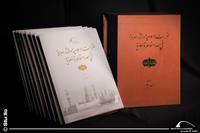The Islamic Attractions and Arab Antiquities in Egypt and Moez Cairo
Posted on

The BA Islamic Civilizations Studies Center recently issued The Islamic Attractions and Arab Antiquities in Egypt and Moez Cairo (Al-Mazarat Al-Islamiyya wa Al-Athar Al-Arabiyya fi Misr wa Al-Qahera Al-Muizziyya) encyclopedia in eight volumes, by Hassan Kassem and critically edited by a number of researchers.
This Encyclopedia is considered the most comprehensive source of the history of Cairo mosques and those of the Egyptian nation at large, its attractions and haunts, ancient and modern maps and plans, historical and archeological sites, biographies of its scholars, kings and princes and genealogies and family trees. It is the fruit of intensive research, observations, and scientific excavations carried out by the author who documented them chronologically over several years of hard work. The title interests itself in the history of the Islamic architectural heritage in Egypt since the Islamic fatah until the modern age: starting with the early Islamic conquests through the Tulunid, Ikhshidid, Fatimid, Ayyubid, Mamluk, Ottoman and Mohamed Ali dynasties until the end of the 1960s.
In the First Volume, the author gives an introduction about the history of Islamic art and architecture, and describes the main elements of Islamic architecture: minarets, domes, and mihrab (prayer niche).
The Second Volume deals with the early Islamic antiquities such as the Mosque of Amr bin El-Ass- Egypt’s first Islamic mosques, and Ahmed bin Toloun Mosque- the pearl of Islamic architecture, in addition to the Fatimid mosques in Cairo, Aswan, Upper Egypt, Alexandria and Sinai. He listed them chronologically, and attached a study on measuring the Saladin Citadel of Cairo, palaces, sabils, baths and schools.
The Third Volume tackles the emergence of education centers in Cairo, followed by the antiquities of the seventh and eighth hijri centuries- the Ayyubid and Mamluk dynasties.
Volume Four includes attractions of the ninth and tenth hijri centuries, followed by an appendix on the antiquities of the Cairo Necropolis of the Mamluk era in southeast Cairo.
Volume Five is dedicated to Ottoman attractions from the second half of the tenth hijri century until the end of the twelfth hijri century.
Volume Six has a comprehensive overview of ancient mosques in old maps of Cairo and Fustat, as well as historical description of some of these.
Volume Seven includes modern mosque established by the Ministry of Endowments in the twentieth century as well as recorded and unrecorded Sharif sights in Cairo and Aswan. While Volume Eight is the index, maps and references.